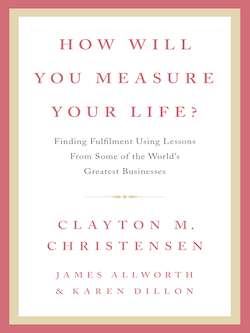Читать книгу How Will You Measure Your Life? - Clayton Christensen - Страница 9
ОглавлениеWHEN YOU WERE ten years old and someone asked you what you wanted to be when you grew up, anything seemed possible. Astronaut. Archaeologist. Fireman. Baseball player. The first female president of the United States. Your answers then were guided simply by what you thought would make you really happy. There were no limits.
There are a determined few who never lose sight of aspiring to do something that’s truly meaningful to them. But for many of us, as the years go by, we allow our dreams to be peeled away. We pick our jobs for the wrong reasons and then we settle for them. We begin to accept that it’s not realistic to do something we truly love for a living.
Too many of us who start down the path of compromise will never make it back. Considering the fact that you’ll likely spend more of your waking hours at your job than in any other part of your life, it’s a compromise that will always eat away at you.
But you need not resign yourself to this fate.
I had been out of college and in the working world for years before I figured out that I could make it back to school to teach and develop a generation of wonderful young people. For a long time, I had no idea that this might be possible. Now there’s nothing I would rather be doing. Every day I think of how fortunate I am.
I want you to be able to experience that feeling—to wake up every morning thinking how lucky you are to be doing what you’re doing. Together, in the next chapters, we’re going to build a strategy for you to do exactly that.
A strategy? At a basic level, a strategy is what you want to achieve and how you will get there. In the business world, this is the result of multiple influences: what a company’s priorities are, how a company responds to opportunities and threats along the way, and how a company allocates its precious resources. These things all continuously combine, to create and evolve a strategy.
You don’t need to think about this for more than a minute, however, before you realize that this same strategy-making process is at work in every one of us as well. We have intentions for our careers. Against those intentions, opportunities and threats emerge that we haven’t anticipated. And how we allocate our resources—our time, talent, and energies—is how we determine the actual strategy of our lives. Occasionally, the actual strategy maps quite closely with what we intended. But often what we actually end up doing is very different from what we set out to do.
The art of managing this, however, is not to simply stomp out anything that was not a part of the original plan. Among those threats and opportunities that we didn’t anticipate, there are almost always better options than were contained in our original plans. The strategist in us needs to figure out what these better things are, and then manage our resources in order to nourish them.
The following chapters are all designed to help you leverage these concepts in answering the question “How can I find happiness in my career?”
The starting point for our journey is a discussion of priorities. These are, in effect, your core decision-making criteria: what’s most important to you in your career? The problem is that what we think matters most in our jobs often does not align with what will really make us happy. Even worse, we don’t notice that gap until it’s too late. To help you avoid this mistake, I want to discuss the best research we have on what truly motivates people.
Following this, I will outline how best to balance our plans to find something that we truly love doing with the opportunities and challenges that we never expected to arise in our lives. While some people will argue that you should always have the next five years of your life planned out, others have followed a strategy of just seeing what has come along and will tell you that it’s worked well for them. There’s a time and a place for both approaches. Drawing on our research, I will explain what the best circumstances are to be deliberate, to have that plan; and when it’s best to be emergent—to be open to the unexpected.
The final element is execution. The only way a strategy can get implemented is if we dedicate resources to it. Good intentions are not enough—you’re not implementing the strategy that you intend if you don’t spend your time, your money, and your talent in a way that is consistent with your intentions. In your life, there are going to be constant demands for your time and attention. How are you going to decide which of those demands gets resources? The trap many people fall into is to allocate their time to whoever screams loudest, and their talent to whatever offers them the fastest reward. That’s a dangerous way to build a strategy.
All of these factors—priorities, balancing plans with opportunities, and allocating your resources—combine to create your strategy. The process is continuous: even as your strategy begins to take shape, you’ll learn new things, and new problems and opportunities will always emerge. They’ll feed back in; the cycle is continuous.
If you can understand and manage this strategy process, you’ll have the best shot at getting it right—of having a career that you will truly love.
Even if you don’t end up getting to be an astronaut.
